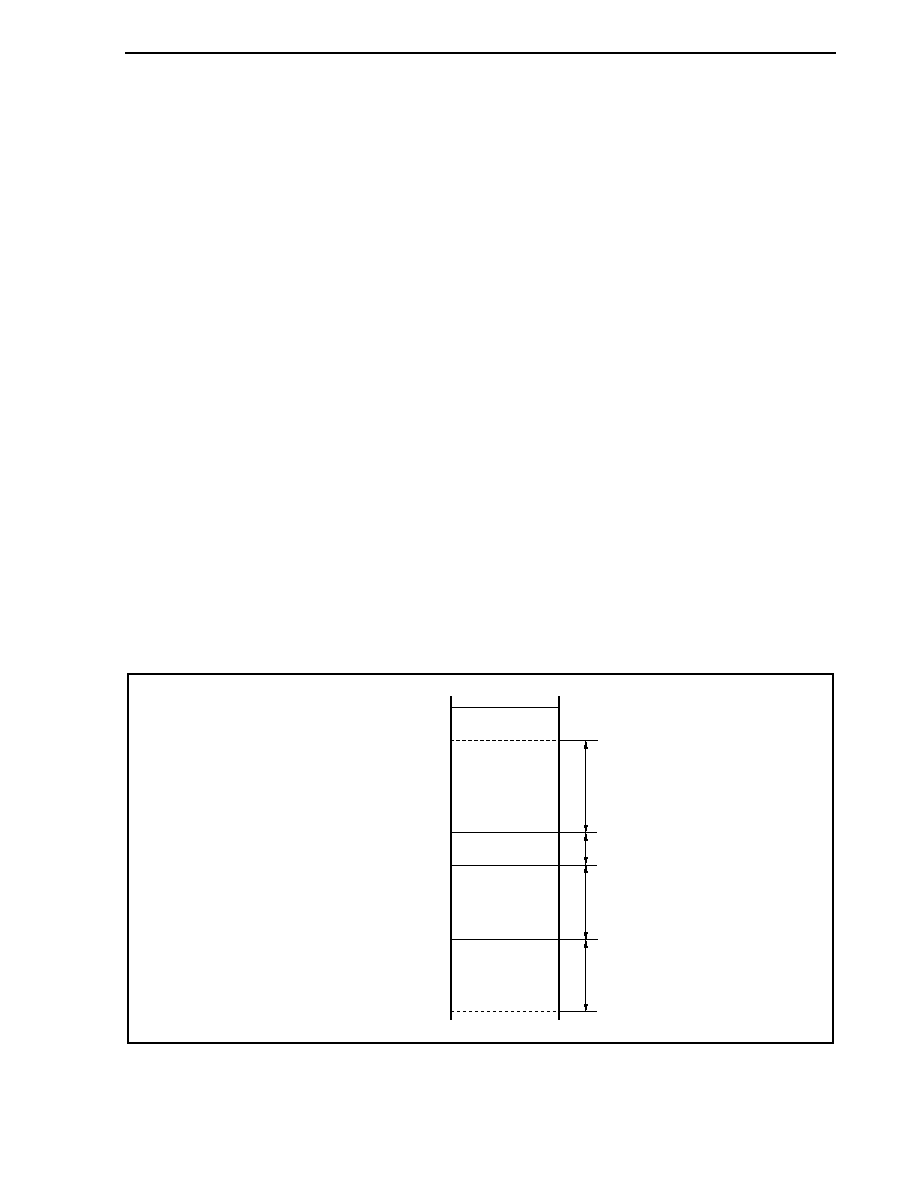- 您现在的位置:买卖IC网 > Sheet目录3880 > PIC24F08KL302-I/SO (Microchip Technology)IC MCU 16BIT 8KB FLASH 28-SOIC

CHAPTER 3 CPU FUNCTION
User’s Manual U15905EJ2V1UD
73
3.4.6
Recommended use of address space
The architecture of the V850ES/SA2 and V850ES/SA3 requires that a register that serves as a pointer be secured
for address generation when operand data in the data space is accessed. The address stored in this pointer
±32 KB
can be directly accessed by an instruction for operand data. Because the number of general-purpose registers that
can be used as a pointer is limited, however, by keeping the performance from dropping during address calculation
when a pointer value is changed, as many general-purpose registers as possible can be secured for variables, and the
program size can be reduced.
(1) Program space
Of the 32 bits of the program counter (PC), the higher 6 bits are fixed to 0, and only the lower 26 bits are valid.
Regarding the program space, therefore, a 64 MB space of contiguous addresses starting from 00000000H
unconditionally corresponds to the memory map.
To use the internal RAM area as the program space, access addresses 3FFC000H to 3FFEFFFH.
(2) Data space
With the V850ES/SA2 and V850ES/SA3, it seems that there are sixty-four 64 MB address spaces on the 4 GB
CPU address space. Therefore, the least significant bit (bit 25) of a 26-bit address is sign-extended to 32 bits
and allocated as an address.
(a) Application example of wrap-around
If R = r0 (zero register) is specified for the LD/ST disp16 [R] instruction, a range of addresses 00000000H
±32 KB can be addressed by sign-extended disp16. All the resources of the internal hardware can be
addressed by one pointer.
The zero register (r0) is a register fixed to 0 by hardware, and practically eliminates the need for registers
dedicated to pointers.
Figure 3-10. Application Example of Wrap-Around (V850E/SA3)
Internal ROM area
Internal peripheral
I/O area
Access prohibited
area
Internal RAM area
32 KB
4 KB
16 KB
12 KB
(R = )
0003FFFFH
00007FFFH
00000000H
FFFFF000H
FFFFEFFFH
FFFFB000H
FFFFAFFFH
FFFF8000H
发布紧急采购,3分钟左右您将得到回复。
相关PDF资料
XF2L-0535-1
CONN FPC 5POS 0.5MM SMT
PIC18LF23K22-I/SS
IC PIC MCU 8KB FLASH 28SSOP
PIC16LF1933-I/ML
IC PIC MCU FLASH 4K 28-QFN
PIC16F1933-I/ML
IC MCU 8BIT FLASH 28-QFN
PIC16F785-I/ML
IC PIC MCU FLASH 2KX14 20QFN
XF2L-0425-1
CONN FPC 4POS 0.5MM SMT
PIC16F1933-I/MV
IC MCU 8BIT FLASH 28-UQFN
PIC16F785-I/SO
IC PIC MCU FLASH 2KX14 20SOIC
相关代理商/技术参数
PIC24F08KL302-I/SP
功能描述:16位微控制器 - MCU 8KB FLASH 1KB RAM 256B 3V RoHS:否 制造商:Texas Instruments 核心:RISC 处理器系列:MSP430FR572x 数据总线宽度:16 bit 最大时钟频率:24 MHz 程序存储器大小:8 KB 数据 RAM 大小:1 KB 片上 ADC:Yes 工作电源电压:2 V to 3.6 V 工作温度范围:- 40 C to + 85 C 封装 / 箱体:VQFN-40 安装风格:SMD/SMT
PIC24F08KL302-I/SS
功能描述:16位微控制器 - MCU 8KB FLASH 1KB RAM 512B 3V 10-BIT ADC RoHS:否 制造商:Texas Instruments 核心:RISC 处理器系列:MSP430FR572x 数据总线宽度:16 bit 最大时钟频率:24 MHz 程序存储器大小:8 KB 数据 RAM 大小:1 KB 片上 ADC:Yes 工作电源电压:2 V to 3.6 V 工作温度范围:- 40 C to + 85 C 封装 / 箱体:VQFN-40 安装风格:SMD/SMT
PIC24F08KL302T-I/ML
功能描述:16位微控制器 - MCU 8KB FLASH 1KB RAM 512B 3V 10-BIT ADC RoHS:否 制造商:Texas Instruments 核心:RISC 处理器系列:MSP430FR572x 数据总线宽度:16 bit 最大时钟频率:24 MHz 程序存储器大小:8 KB 数据 RAM 大小:1 KB 片上 ADC:Yes 工作电源电压:2 V to 3.6 V 工作温度范围:- 40 C to + 85 C 封装 / 箱体:VQFN-40 安装风格:SMD/SMT
PIC24F08KL302T-I/MQ
功能描述:16位微控制器 - MCU 8KB FL 1KB RAM 256B 3V RoHS:否 制造商:Texas Instruments 核心:RISC 处理器系列:MSP430FR572x 数据总线宽度:16 bit 最大时钟频率:24 MHz 程序存储器大小:8 KB 数据 RAM 大小:1 KB 片上 ADC:Yes 工作电源电压:2 V to 3.6 V 工作温度范围:- 40 C to + 85 C 封装 / 箱体:VQFN-40 安装风格:SMD/SMT
PIC24F08KL302T-I/SO
功能描述:16位微控制器 - MCU 8KB FLASH 1KB RAM 512B 3V 10-BIT ADC RoHS:否 制造商:Texas Instruments 核心:RISC 处理器系列:MSP430FR572x 数据总线宽度:16 bit 最大时钟频率:24 MHz 程序存储器大小:8 KB 数据 RAM 大小:1 KB 片上 ADC:Yes 工作电源电压:2 V to 3.6 V 工作温度范围:- 40 C to + 85 C 封装 / 箱体:VQFN-40 安装风格:SMD/SMT
PIC24F08KL302T-I/SS
功能描述:16位微控制器 - MCU 8KB FLASH 1KB RAM 512B 3V 10-BIT ADC RoHS:否 制造商:Texas Instruments 核心:RISC 处理器系列:MSP430FR572x 数据总线宽度:16 bit 最大时钟频率:24 MHz 程序存储器大小:8 KB 数据 RAM 大小:1 KB 片上 ADC:Yes 工作电源电压:2 V to 3.6 V 工作温度范围:- 40 C to + 85 C 封装 / 箱体:VQFN-40 安装风格:SMD/SMT
PIC24F08KL401
制造商:MICROCHIP 制造商全称:Microchip Technology 功能描述:Low-Power, Low-Cost, General Purpose 16-Bit Flash Microcontrollers with nanoWatt XLP Technology
PIC24F08KL401-I/MQ
功能描述:16位微控制器 - MCU 8KB FLASH 1KB RAM 512B 3V 10-BIT ADC RoHS:否 制造商:Texas Instruments 核心:RISC 处理器系列:MSP430FR572x 数据总线宽度:16 bit 最大时钟频率:24 MHz 程序存储器大小:8 KB 数据 RAM 大小:1 KB 片上 ADC:Yes 工作电源电压:2 V to 3.6 V 工作温度范围:- 40 C to + 85 C 封装 / 箱体:VQFN-40 安装风格:SMD/SMT